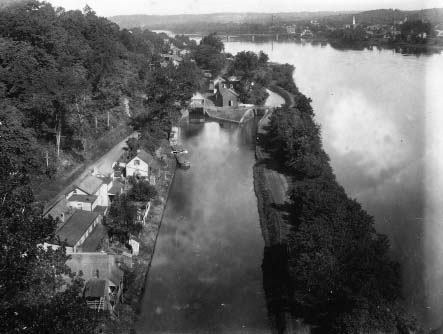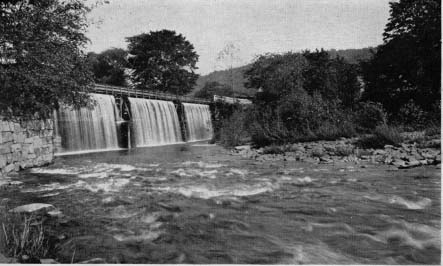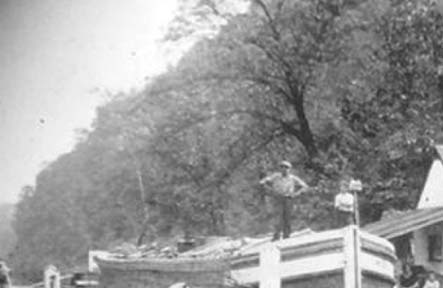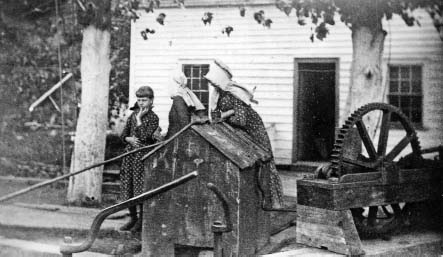The Delaware Canal (8 page)
Read The Delaware Canal Online
Authors: Marie Murphy Duess

Crossing the river from New Hope to New Jersey required skill and precision. There were specially trained workers on the New Jersey side who would take a flat-bottomed boat across the Delaware from Lambertville, and while doing so would gauge the speed of the river's current, its depth and how the weather would affect the crossing. If the river was low, some of the boat's load was transferred to an empty scow to adjust the draft of the boat. The scow would be attached to the boat or brought over separately. When the workers reached the boat waiting to cross, they tied a rope to the stern of the boat and attached the rope to a winch connected to a cable that was secured to a tower upstream from the outlet lock. With a long-handled bar placed into a hole in the winch, the men would tighten the rope to draw the boat carefully out of the lock and into an eddy, holding it steady against the current. One end of the line from the pulley was secured to the bow of the boat and the other end hooked to the side. By adjusting the length of the rope attached to the side of the boat, the pilots could change the angle of the boat to accommodate its speed and ensure the safest passage across the current. Controlling the speed of the boat was extremely important. A boat that crossed too quickly could jam or damage the outlet gates, requiring costly and time-consuming repairs.

There were four locks in New Hope, including an outlet lock that allowed cargo boats to cable across to the New Jersey side of the river.
Courtesy of the New Hope Historical Society
.
Once on the New Jersey side, the boats were hooked up to mules again, which pulled them through the locks to the Raritan feeder and then proceeded down the Raritan Canal to New Brunswick. From there the boats moved on to New York.
There were nine aqueducts on the Delaware Canal that conveyed the canal over streams and depressions in the ground below the bottom of the canal. They were made of wood at first and the ends rested on stone masonry built into the canal. The aqueducts were usually the same depth as the canal, 20 feet wide and ranged in length from 25 to 178 feet. The towpaths were connected on each side of an aqueduct by a wooden platform. Where smaller streams that didn't require aqueducts were located, culverts were installed so that the water could flow beneath. There were twenty culverts in total, and they consisted of arched masonry or large tubes.
Controlling the level of the water in the canal was tantamount to its safety and that of the boats. In addition to feeding water into the canal by several methods when it was running dry, it was equally important to lower the water when it was too high.

Tohicken Aqueduct.
Courtesy of Historic Langhorne Association
.
When the water rose slightly above normal level, it was controlled automatically through overflows, which were reinforced depressions that directed the overflowing water into lower ground beyond the canal bank. If the water rose to a dangerous level, special gates at the top of a waste weir were opened to allow the water to escape from the canal. These were also used to drain the canal between locks when maintenance or repairs were required. In order to regulate the height of the water in the canal, stop gates were also installed at certain points. They were normally open, but could be closed quickly in the event of a flood. There were nineteen waste weirs and eight stop gates on the Delaware Canal.
Considering that time was money for the boatmen, going through locks efficiently, controlling the water and crossing the Delaware were of great concern, and sometimes caused serious distress. The faster the boats moved through the locks the better, and when it took longer than they wanted, the lock keeper received the brunt of the boatmen's wrath. Not that the lock tenders worried too muchâthey could easily exact revenge on an offending captain since they were in complete control of the passage on the canal.
The Keepers of the Locks
The canal system in Pennsylvania spurred economic growth in a new and expanding country and provided employment for boat builders, boatmen, manufacturers, agricultural suppliers, merchants and others (even prostitutes) who earned their living in the canal industry. Thousands of Americans, as well as immigrants, found employment in canal construction, maintenance and operation.
When the construction of the Delaware Canal was nearing the end, lock keepers were appointed by the canal commissioners. Several of them had participated in building the canal, and some were local residents. According to the
Delaware Canal Journal
by C.P. “Bill” Yoder, the following men had been assigned as the first lock tenders on the Delaware Division Canal:
John I Hibbs would work at Lock Number 1 and the Tide Lock at Bristol
Elias Gilkyson was assigned locks 2 and 3 (Bristol)
Daniel Kirgen was on 4 (Tullytown)
Charles Shoemaker, 5 (Yardley)
Joseph Suber, 6 (located between Yardley and Taylorsville)
David Kirgen, 7 (North of Yardley)
Samuel Daniels oversaw 8 and 9 and the Guard Lock at New Hope
Samuel Stockdan worked locks 10 and 11 (New Hope)
John Everitt, 12 (Lumberville)
George Solliday, 13 and 14 (Point Pleasant)
Mahlon Smith, 15 and 16 (Smithtown)
John Speer, 17 (just south of Tinicum)
Ralph Harrison, 18 (Uhlerstown)
George Fox, 19 (Lodi)
Wyllys Rogers, 20 (Kintnersville)
Charles Wagener, 21 (Durham Furnace)
and Joseph Shepherd, 22 and 23 (Raubsville)
Lock 24 at Easton did not have an assigned locktender right away
.
In the early years of the canal, the locks were open all day and all night. Around 1855, this changed, and the lock tenders worked from four o'clock in the morning until they closed the locks at ten at night, six days a week. During the height of the canal age, the boatmen kept the lock tenders very busy. At the peak of operations on the canal in the mid-1800s, as many as between twenty-seven hundred and three thousand boats were logged at the tollhouse at Bristol. Boats could make as many as twenty-five to twenty-eight round trips throughout the operating months from mid-March to mid-December.
Most of the homes in which the lock keepers and their families lived were owned by the company. They were usually very tiny, of saltbox design and made of fieldstone or wood, sometimes with no more than two rooms on the first floor and a loft for sleeping above. Many of the lock tenders farmed the land around the homes and kept goats, chickens and other livestock in order to feed their families.

A good lock keeper would start to fill the lift lock as soon as he heard the sound of the boatman's conch shell so the boat could lock through quickly and continue on its way.
Courtesy of the Historic Langhorne Association
.
When they heard the call of the conch shell that the boatmen used to notify the lock tenders of their approach, they would respond with their own whistles or horns. Three blasts meant hold your position; one meant it was clear for the boat to approach. Once they were adept at figuring out from which direction the sound of the conch shell had come, efficient lock keepers would be certain to have the lock filled with water even before seeing the boat approach. It wasn't unusual for there to be several boats in line waiting to pass through a lock, especially at single locks, and the boatmen were very impatient. Occasionally they tried to pass the boat in front of them to get to the lock first, causing arguments that often erupted into fistfights. According to the Bucks County Historical Society, “Fights took place nearly every day at the locks and at the tie-up places.”
36
Lock tenders kept order at the locks, or at least tried to. The Board of Canal Commissioners had set in place official regulations that the canal men were expected to respect, and they were fined when they violated those laws. Bickering and brawling were violations, and heavy fines were doled out to captains who failed to yield the right of way. There were rules as to which boats went through a lock first. Any boat arriving within one hundred yards of a lock would be allowed to pass first. When lock keepers felt that boatmen were flagrantly disregarding the rules of lockage, they would report the violators to the canal boss, who in turn would catch up to the offenders and administer a stiff fine.
It was also the lock tender's responsibility to keep the overflow control gates set and make certain that the sluiceways were clean and working. Depending upon where their locks were located, they may have been in charge of the waste gate. The company relied on them to report damages or leaks and, when possible, make repairs. They took care of their lock houses and the land on which the houses were located. They even hunted muskrats, which burrowed into the banks of the canal and caused some of the worst damage, often as much as $5,000 worth of damage. For all of this, the lock keepers were paid $4 a day and given free housing by the company.
They were expected to live by rules just as the canal men were, and they could lose their employment if reported by a canal boss for violations. They could be fired for being found drunk while working (and they worked just about all the time) or if they were away from the lock tender house for more than a week, regardless of whether they had someone else working the locks. They couldn't disturb their neighbors and, for the most part, were expected to respect the boatmen and not cause trouble with them or among them.

Some lock tenders' children learned how to operate the gates at a young age. Mechanisms were protected in a “doghouse” similar to this one.
Courtesy of the Pennsylvania Canal Society Collection, National Canal Museum, Easton, PA
.
Appointments of lock tenders were political, and being given the job of moving into a suspended lock tender's house depended upon which political party was holding the reins at the time. There were some who were well liked and kept their jobs until their deaths, and even after their deaths their wives and children were permitted to carry on.
To make extra money during the canal season, some of the lock tenders' wives took in the boatmen's laundry, baked breads and pies to sell to them and occasionally ran stores where the boatmen could purchase supplies and food. There were lock tenders who worked second jobs or farmed the land, so they trained their wives and children in the mechanics of operating the locks while they were away from their stations. Lock tenders normally worked on the maintenance and repair of the canal during the winter months, and they cut ice when the canal and river froze over and sold it to the icehouses. And there were times when it was their unfortunate job to help fish a dead mule or a human body out of the dark waters of the canal.